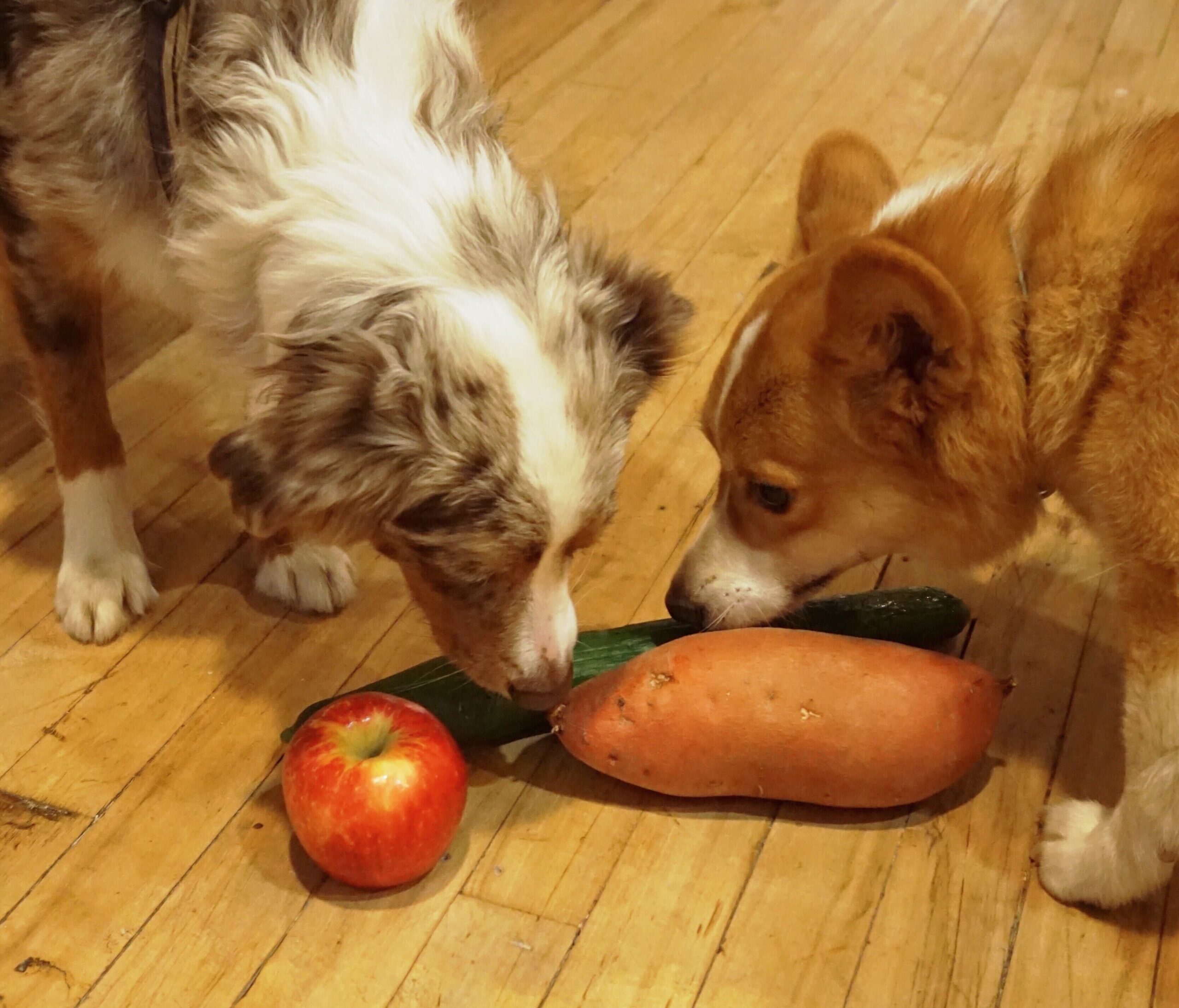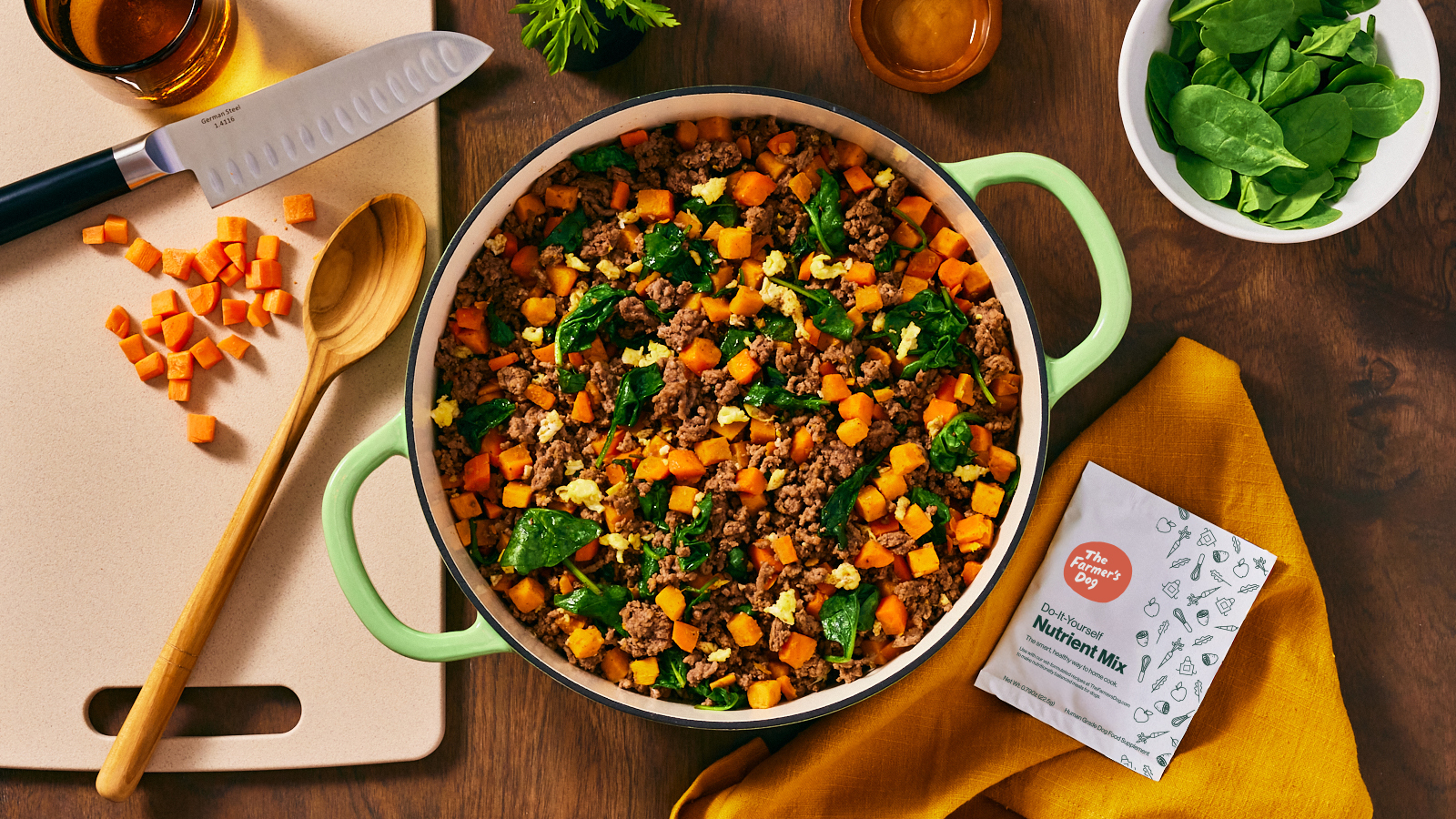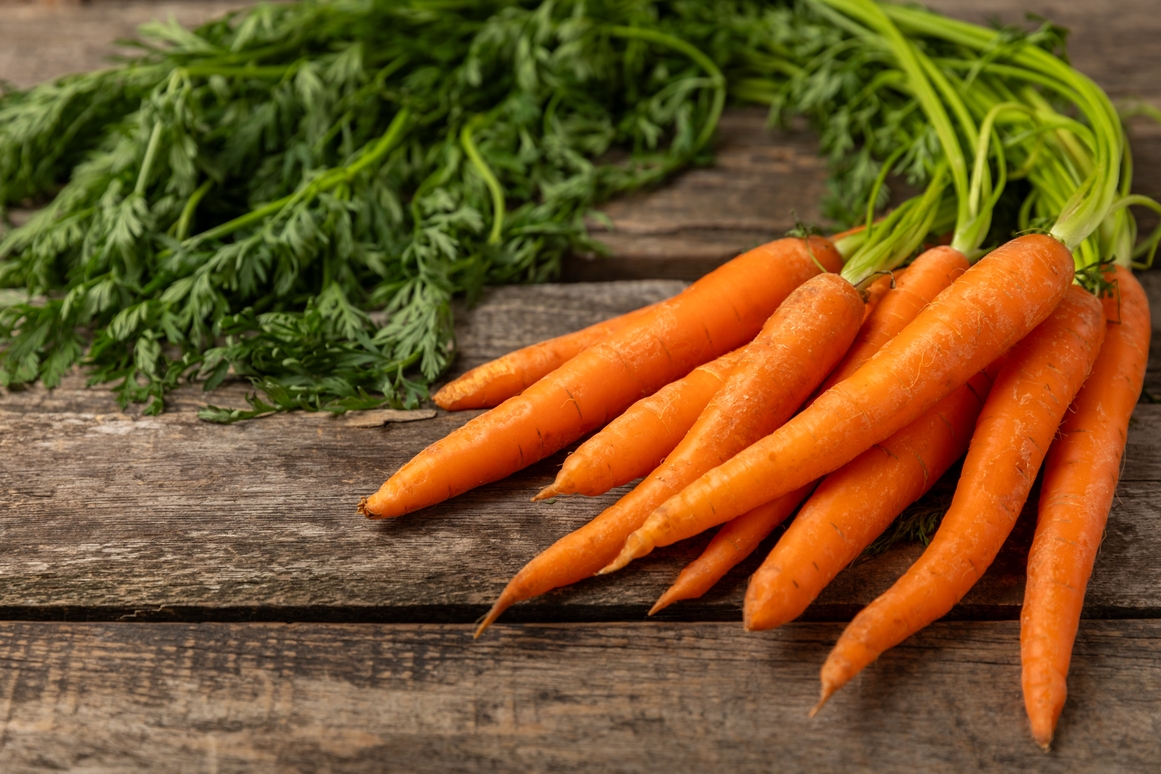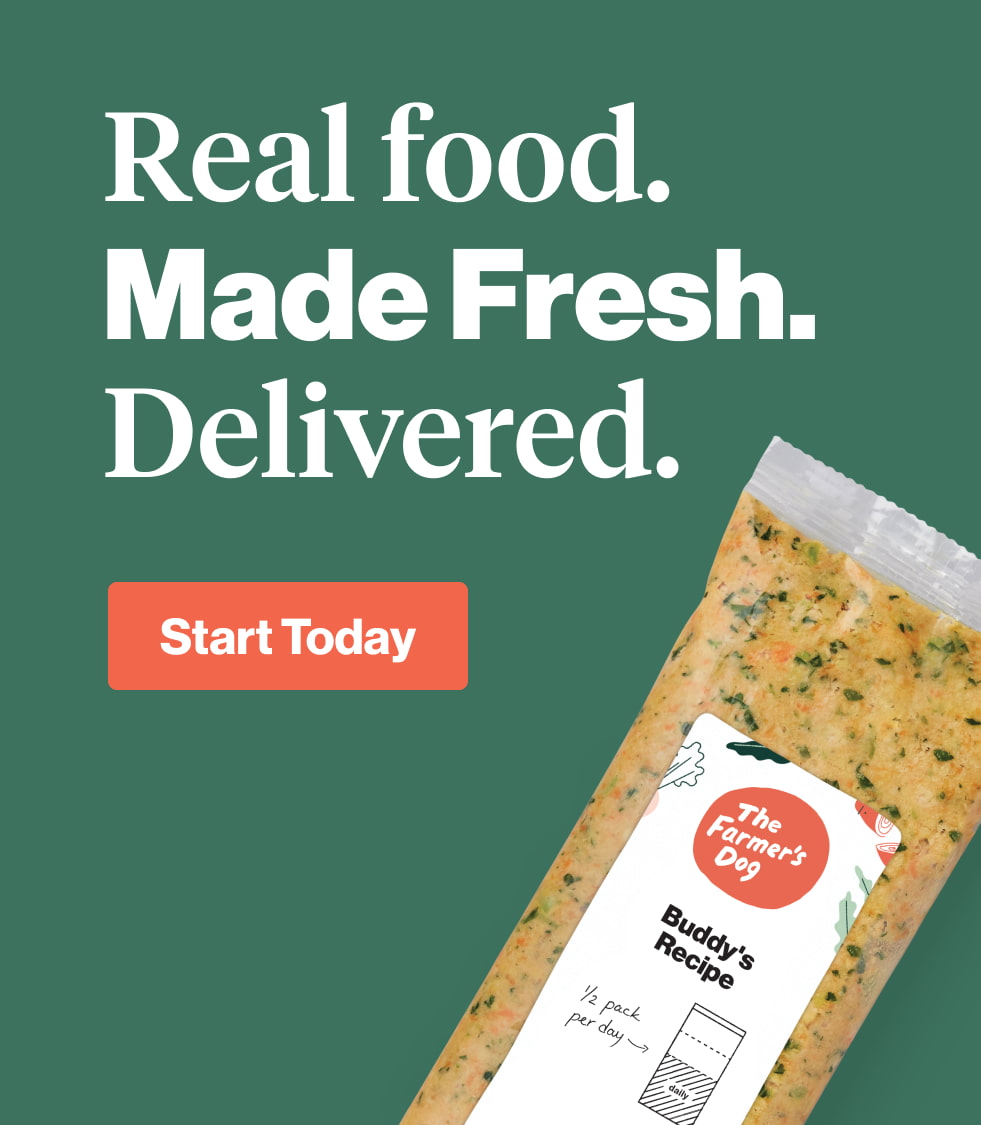
This article was updated in August of 2025.
In this article:
• What are the risks and benefits of dog treats?
• What are some great fresh treats for my dog?
• Are there treats that I can only give my dog in small quantities?
• Which foods should I never give my dog?
• How many treats should I give my dog?
In theory, if your dog is eating a complete and balanced diet, they don’t need any snacks or treats. But let’s be real: Treats are useful for training—and dogs, like people, love a good snack. We can’t deny the excitement and happiness that a small morsel of something tasty can inspire for us and them.
If you want a treat that will fit seamlessly into your dog’s diet, and won’t interfere with their ideal calorie count, we recommend our own Snap Sticks, which are made with simple human-grade ingredients. When we send you Snap Sticks, we provide personalized serving limits for your dog—making it easy to keep them in ideal body condition.
And, if you’re looking for more healthy treat options, some fresh foods that may already be in your refrigerator can make good options for dogs. Just be sure that you’re feeding your dog the right things, and in the right quantities.
Here is a roundup of simple, fresh snacks that both of you will feel great about, plus some tips for choosing and feeding treats.
Fruits and vegetables that are great for dogs (in moderation)
Apples
An apple a day won’t keep the vet away, and that’s for the best—vets are really important. But apples do make a healthy snack for dogs. They are relatively high in fiber, which can aid in your dog’s digestion. (Caution: There’s a risk of cyanide poisoning if a dog consumes enough apple seeds. At lower levels, they can still cause gastrointestinal upset. So always remove the seeds and core before offering an apple to your pup.)
Serving tip: If your dog loves apples, cut them into cubes and take them on your next walk to practice recall, good leash etiquette, and more.
Bananas
Bananas are low in cholesterol and sodium, are relatively high in fiber, and contain potassium, vitamins (including vitamin C), fiber, and copper. Keep in mind that a small banana has 12 grams of sugar—so, like all snacks, bananas should be served in moderation.
Serving tip: Try mashing an appropriate portion for your dog and putting it in a Kong or spreading it over a lick pad to provide extra mental enrichment.
Bell Peppers
Packed with vitamins and antioxidants, slices of raw red peppers can be a sweet treat as long as you remove the stems and seeds. Be sure to keep spicy peppers away from your dog, as they can cause digestive upset.
Serving tip: These are also great for puzzles and Kongs, cut into cubes or julienned.
Blueberries
Blueberries are not only rich in antioxidants, including vitamins C and K, and high in fiber, but also contain good-for-you phytochemicals, including anthocyanins, which give them their color.
Serving tip: Breaking open blueberries can unleash their scent and make them more interesting to your dog.
Carrots
Carrots are rich in nutrients like fiber and the antioxidant beta-carotene. The texture of carrots may also help remove film from the surface of teeth and do a small part in helping prevent the buildup of plaque (but it’s no replacement for brushing!) Make sure to monitor your dog’s chewing so that they do not gulp large pieces of carrot—these can be a choking hazard.
Serving tip: Cutting up carrots and placing them in toys—like Kongs—is a great way to add mental stimulation to your dog’s day.
Cucumbers
Cucumbers contain nearly no fats or oils. They are, however, loaded with nutrients like potassium, copper, magnesium, biotin, and vitamins K, C, and B-1. The high water content in cucumbers will help hydrate your dog, so they’re especially good for summer and active days.
Serving tip: Slice them up and add to water to interest your dog. Now it’s spa water for dogs.
Green Beans
A crunchy source of iron, calcium, fiber, folic acid, niacin, potassium, beta-carotene, and vitamins A, C, and K, green beans are another excellent choice. Only feed fresh or canned varieties, without any added salt.
Serving tip: These can be cut up as walk treats, or placed in puzzles or Kongs.
Pumpkin
Pumpkin is rich in beta-carotene—the antioxidant responsible for its rich orange color—as well as such nutritional powerhouses as fiber, potassium, and vitamin C.
We recommend canned pumpkin puree with no added ingredients—never pie filling. Pumpkin pie filling may contain ingredients like sugar, spices, and xylitol—the latter of which is poisonous to dogs.
Consider subbing in pumpkin for peanut butter—it’s about five calories per tablespoon versus 100 calories for the same amount of peanut butter.
Serving tip: Pumpkin spreads well on lick pads, which are soothing for dogs.
Strawberries
Strawberries are a great source of fiber and vitamin C, but like bananas, strawberries are high in sugar, and so should be fed only in small portions.
Feed fresh or frozen berries without anything added. Avoid canned fruit in syrup or with added sugar. If strawberries are a new treat, start out with small amounts to avoid stomach upset.
Serving tip: Try freezing them or stocking your freezer with the already-frozen variety. It makes for a cooling summer treat.
Watermelon
Consisting of 92% water, watermelon is a tasty treat that can help keep your dog hydrated on a hot day. It’s also packed with nutrients like potassium and vitamins A, B-6, and C.
Remove the rind and seeds before feeding watermelon to your dog. Watermelon seeds can cause intestinal blockage and digestion problems. The rind can cause gastrointestinal upset.
Serving tip: On hot summer days, consider popping cubed seedless watermelons into your dog’s bowl to encourage hydration.
Snacks that are okay in small quantities
Cheese
Cheese can be a rich source of calcium, which is essential for healthy growth and bone development. But if you’re feeding a complete and balanced diet of fresh food, your dog should be getting the right amount of calcium—too many extras, like cheese, can cause a nutritional imbalance.
That said, cheese can be a delightful treat for most dogs—just keep the portions small and don’t feed every day.
Hard-boiled eggs
Eggs are jam-packed with essential fatty acids, vitamins, and nutrients, plus vitamin D, vitamin A, vitamin B-6, iron, potassium, and magnesium. A chicken egg is about 70 calories, yolk and all, so it’s best given in moderation—but the health benefits of eggs are numerous, and include improved skin and coat.
Hard-boiled eggs are especially good for dogs because they’re cooked without the need to add any oil or butter.
Peanut Butter
Peanut butter is a favorite of many dog owners, since they can spread it on a lick pad, puzzle toy, or in a treat ball for enrichment. But at 100 calories a tablespoon, peanut butter is a high-calorie treat. Giving it too much or too frequently can lead to weight gain. So be sure to offer peanut butter in moderation, and select varieties without added salt or sugar.
Foods you should never feed your dog
While fresh food can be wonderful for your dog’s health, there are some foods that, no matter how fresh, are not good for them—whether it’s because they present choking hazards, are toxic, or will upset their digestion.
Foods that are toxic to dogs include chocolate, garlic, and other alliums like onions and chives. Grapes are poisonous to dogs, too, as are raisins. Also poisonous are macadamia nuts and foods made with xylitol—a natural sugar alcohol that is often used as a sugar substitute in things like gum and some treats for humans (it’s always good to check labels for this ingredient if you’re wondering if your dog can eat a product). While bell peppers are considered safe for dogs, hot peppers contain capsaicin—which can disrupt a dog’s digestion. And, finally, bones of all kinds present a choking hazard.
Always check with your veterinarian before making any dietary changes. Ditto if your dog is exhibiting any behavioral changes or signs of illness.
Practice smart portions
According to the most recent available data from the Association for Pet Obesity Prevention (APOP), 59% of dogs in the U.S. are overweight or obese. Excess weight places dogs at an increased risk for conditions like heart disease, osteoarthritis, and cancer, making it one of the most pressing health issues they face.
Veterinarians, including those from the World Small Animal Veterinary Association (WSAVA), recommend fruits and vegetables because they’re high in nutrients and low in calories. But even these healthy foods can contribute to weight gain if you feed too much of them—so mastering portion control is essential.
You’ve probably heard of the “90/10 rule” stating that treats should comprise no more than 10% of a complete and balanced diet. Precisely measuring 10% isn’t always straightforward, however, and guesstimating can result in overfeeding.
One way to determine calorie count is to consult a food database, like the one provided by the U.S. Department of Agriculture’s Food Data Central. Then, with your dog’s calorie requirements in hand, perform some basic math. For example, say you have a 20-pound dog and you’d like to treat them to a banana. Since they require between 325 to 400 calories a day, a maximum of about 32 to 40 of these calories should come from treats. Feeding her an entire small banana —which contains about 90 calories—would be excessive.
Commercial dog treats are, of course, another option. Keep in mind, however, that they can be laden with extra sugar and undesirable ingredients. Sweeteners are often added to dog treats as a cheap way to give them a smooth feel and pretty look. Companies aren’t required to share what’s in mystery ingredients like “natural flavors”—so what’s in the bag may not be listed clearly on the bag.
On the other hand, Snap Sticks from The Farmer’s Dog contain only simple, human-grade ingredients. They contain no added sweeteners, ultra-processed ingredients like “meat meals,” or hidden ingredients like “natural flavors.”
They’re designed to contain all the benefits of a fresh snack, but are shelf-stable and come with personalized serving limits to make it easy to treat your dog while staying within their caloric needs.
Whether it’s fresh from the fridge or from a bag of Snap Sticks, there are plenty of smart and delicious ways to treat your dog. Now that you’re armed with this knowledge, go forth and keep your dog healthy (and happy).




